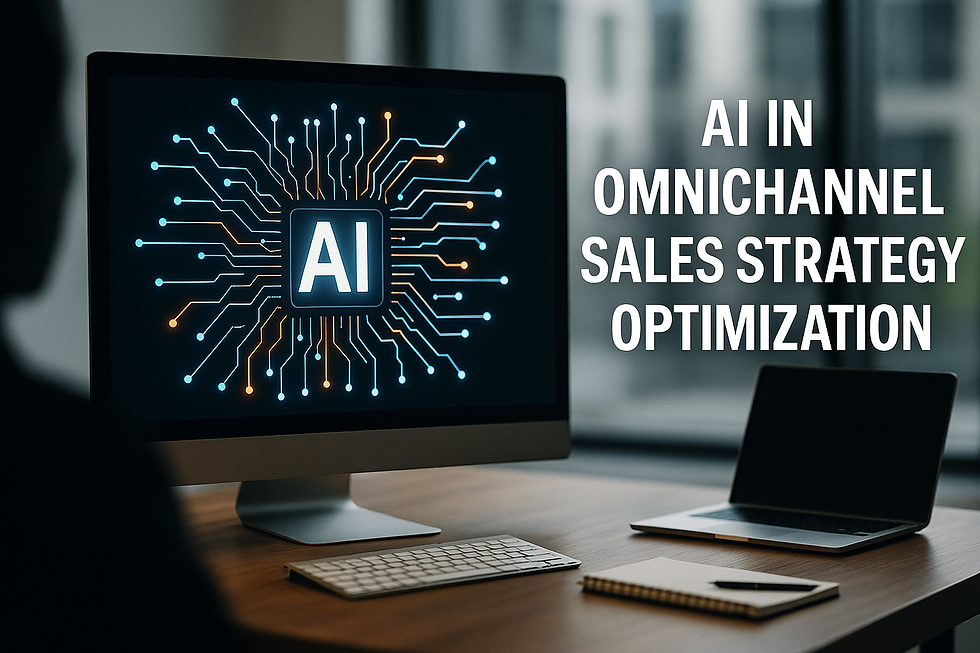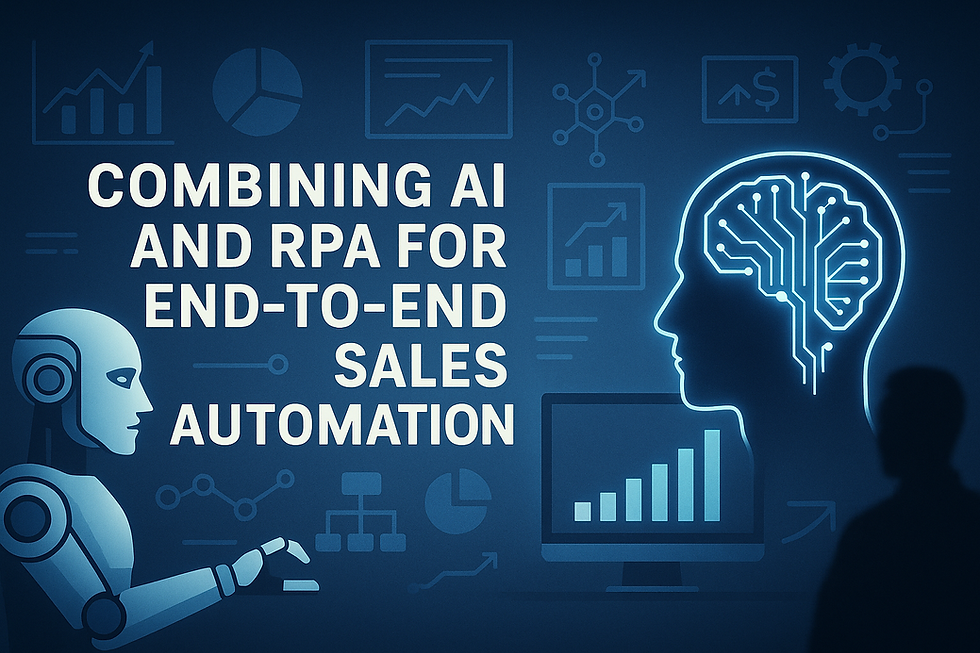AI in Omnichannel Sales Strategy Optimization
- Muiz As-Siddeeqi

- Aug 20
- 5 min read

A Fractured Sales World Is Not the Future — It’s the Past
Walk into any corporate sales war room today, and you'll hear the same cry:
“Our customers are everywhere—but our strategy is not.”
They browse on Instagram but purchase on Amazon. They compare prices on Google but expect in-store pickup. They chat with bots at midnight, call support in the morning, and leave feedback on LinkedIn by lunch. They’re not moving in a straight line. They’re swirling across channels like a storm.
And yet—most businesses still chase them with siloed systems, outdated analytics, and reactive guesswork. This isn’t a strategy. This is survival mode.
This is losing customers who wanted to buy.
But the game is changing—and the players who understand the power of AI in omnichannel sales strategy optimization aren’t just surviving anymore.
They’re thriving.
This is the blog where we unpack exactly how they’re doing it—with documented evidence, real-world case studies, peer-reviewed research, company reports, and actual results. No fluff. No fiction. Only facts.
Let’s rebuild the sales machine.
Let’s reimagine it—with AI.
Bonus: Machine Learning in Sales: The Ultimate Guide to Transforming Revenue with Real-Time Intelligence
What Is Omnichannel Sales Strategy? (And Why AI Must Now Own It)
Omnichannel sales is not just about having a website, a store, and an app. It’s about creating a seamless, connected, real-time personalized experience for customers across all those touchpoints.
According to McKinsey’s 2021 Future of Sales report, over 75% of B2B buyers now prefer remote human interactions or digital self-service over traditional face-to-face sales. Yet, they don’t just use one channel—they jump between 6 or more channels before making a decision.
The Challenge?
Humans can’t track, analyze, and predict behaviors across all channels in real time.
The Solution?
AI can. And it already is.
The Sales Shift: Real Companies, Real Transformations
Case Study: Sephora — AI-Powered Personalization Across Channels
Beauty giant Sephora didn’t just digitize. They unified.
They connected AI recommendation engines in their mobile app with in-store tablet kiosks. Shoppers could scan their face in-store and see personalized suggestions generated by the same algorithms behind their online experience.
Result:
Their omnichannel customers spent 3X more than single-channel customers, according to a 2022 internal Sephora analytics report cited in Harvard Business Review.
Case Study: Starbucks — From Lattes to Machine Learning
Starbucks connected their mobile app, loyalty card, website, and in-store POS system using a centralized AI engine.
The AI tracks purchasing behavior and sends hyper-personalized offers. If a customer buys a cappuccino at 8 AM for 3 days, they’ll get an AI-generated 4th-day coupon—right before 8 AM.
Result:
Their mobile orders grew by 17% YoY, and omnichannel loyalty program users showed double the lifetime value compared to in-store-only buyers (Q2 2023 earnings report).
Let’s Get Technical: What AI Does in Omnichannel Sales Strategy Optimization
1. AI Integrates Data Across Disconnected Silos
Data is trapped in CRMs, web analytics tools, call center logs, social media, POS systems, and ERPs.
AI tools like Salesforce Einstein, Adobe Experience Platform, and Treasure Data CDP ingest, clean, and stitch this data into unified customer profiles in real time. This means a customer’s web visit, support chat, email click, and in-store return are no longer four stories—they're one.
Stat to Know: CDPs using AI increase cross-channel campaign efficiency by 42%, according to a Forrester 2023 report.
2. AI Predicts Customer Intent Across Channels
You can’t optimize what you can’t predict.
AI models trained on historic multi-channel behavior can now predict next steps. Will they abandon cart and check Instagram reviews? Will they visit the store next? AI knows.
Amazon’s AI-driven omnichannel predictions reportedly reduced cart abandonment by 30%, by triggering channel-specific nudges (2022 AWS Reinvent conference case release).
3. AI Automates Real-Time Cross-Channel Actions
AI doesn’t just predict—it acts.
For example, if a buyer reads a blog, visits a product page, then chats with support, AI can immediately:
Trigger a personalized email
Alert a sales rep
Adjust pricing dynamically
Suggest content for retargeting ads
All of this happens in milliseconds. Humans can’t work at this speed.
4. AI Measures and Optimizes Channel Attribution
Who gets credit for the sale? Was it the ad, the chatbot, or the product review?
AI-powered multi-touch attribution models can calculate the real contribution of each channel to a conversion. This helps companies invest in the channels that actually drive revenue.
Gartner’s 2023 Omnichannel Strategy Report found that brands using AI attribution tools optimized spend across channels 27% more effectively than those using traditional last-click models.
Top AI Tools Powering Omnichannel Sales (Real, Not Hype)
We’re not dealing in buzzwords. Here are real tools, real functions, real deployments:
Tool | Company | Function |
Salesforce Einstein | Salesforce | Real-time predictive analytics, dynamic customer journeys |
Adobe Sensei | Adobe | AI-based personalization across web, email, and in-store |
Emarsys | SAP | Omnichannel campaign automation with AI segmentation |
Treasure Data CDP | Arm Holdings | Data unification from POS, IoT, CRM, web |
Insider | Used by Singapore Airlines | AI-powered A/B testing and omnichannel personalization |
Dynamic Yield (by Mastercard) | McDonald's | AI-powered menu personalization across kiosks and app |
Every single one of these tools is being used right now by documented companies in live deployments.
Let’s Talk Results: The AI-Omnichannel Revenue Boost
Real Stats, Real Sources:
Aberdeen Group Report (2023): Companies with strong omnichannel engagement see a 9.5% YoY increase in annual revenue, vs. 3.4% for weaker omnichannel performers.
PwC Future of CX Survey (2022): 32% of customers stop doing business with a brand they love after just one bad omnichannel experience.
Harvard Business Review study (2022): Omnichannel shoppers spend 10% more online and 4% more in-store.
Barriers Are Real — But So Are AI Solutions
Siloed Tech Infrastructure
Fix: AI-powered customer data platforms (CDPs) unify scattered systems.
Inconsistent Brand Messaging
Fix: Generative AI tools ensure tone, style, and content is harmonized across all platforms.
Attribution Confusion
Fix: AI-driven multi-touch models provide true conversion paths.
Manual Decision-Making
Fix: AI doesn’t sleep, doesn’t slow down, and doesn’t forget context.
Don’t Just Read This. Use This.
Here’s what businesses like yours can do now—backed by research and proven deployments.
Audit your channels. If they’re not connected, AI can’t work its magic.
Invest in a CDP. No omnichannel AI strategy works without a unified view.
Start small. Deploy AI in one channel (like email automation), then scale.
Connect AI to sales KPIs. Not vanity metrics. Track conversions, LTV, retention.
Learn from others. Read case studies. Follow what Sephora, Starbucks, and McDonald's did.
Final Word: It’s Not “Omnichannel” Anymore. It’s “AI Everywhere.”
The future of sales isn’t just cross-channel. It’s AI-led, customer-driven, and real-time responsive.
You don’t win by shouting louder across every channel.
You win by listening better, predicting smarter, and personalizing deeper.
And that’s something only AI can do at scale.
It’s not hype. It’s not a trend.
It’s already here. And it’s transforming the way the world sells.

$50
Product Title
Product Details goes here with the simple product description and more information can be seen by clicking the see more button. Product Details goes here with the simple product description and more information can be seen by clicking the see more button

$50
Product Title
Product Details goes here with the simple product description and more information can be seen by clicking the see more button. Product Details goes here with the simple product description and more information can be seen by clicking the see more button.

$50
Product Title
Product Details goes here with the simple product description and more information can be seen by clicking the see more button. Product Details goes here with the simple product description and more information can be seen by clicking the see more button.






Comments